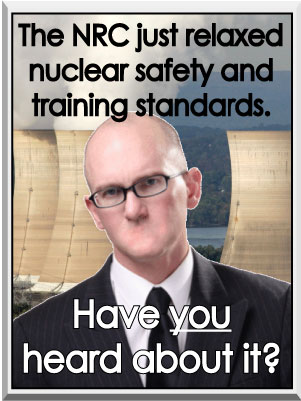 Nuclear Regulatory Commission (NRC) is responsible for oversight of America’s nuclear industry. As you might expect (or at least hope), they have detailed regulations on every phase of nuclear power production, as well as requirements for security of the plants, environmental regulations, public safety, and emergency procedures. As you also might expect, (but not really hope) it’s the target of lobbyist cash carpet-bombing as the industry tries to write the regulations they will live under. This political fight came into the public spotlight most recently with the resignation of NRC Chairman Gregory Jackzo, a longtime defender of public safety against the interests of the industry.
Nuclear Regulatory Commission (NRC) is responsible for oversight of America’s nuclear industry. As you might expect (or at least hope), they have detailed regulations on every phase of nuclear power production, as well as requirements for security of the plants, environmental regulations, public safety, and emergency procedures. As you also might expect, (but not really hope) it’s the target of lobbyist cash carpet-bombing as the industry tries to write the regulations they will live under. This political fight came into the public spotlight most recently with the resignation of NRC Chairman Gregory Jackzo, a longtime defender of public safety against the interests of the industry.
You can get furious about Greg’s ouster if you want, but this month’s Furious isn’t about him. It’s about the newest revision of the safety and security standards for reactors. A May article from AP describes these first new changes in three decades, and points out how quietly they were planned and implemented. Among the changes they mentioned were:
- Requiring fewer exercises for major accidents
- Recommending a smaller evacuation zone in case of radiation release
- Eliminating the requirement for local responders to always run practice exercises for radiation release
- Eliminating the requirement for local responders to participate in attack drills with plant security
- Adding a requirement for exercises in which no radiation is released
Now, it makes sense to check regulations and standards from time to time. After all, things change and the assumptions in place when the regulations were written may not make sense in today’s world. But there’s a couple things with this revision-
- The overhaul process has been going on for over 4 years, but was closed out without incorporating lessons from the Fukushima disaster.
- Since few of us are qualified to evaluate these changes, we have to count on qualified nuclear watchdog groups to stay up on these things. Despite the 4-year process, the NRC managed to fly under all their radars. For example, the director of the Nuclear Information and Resource Service had to learn about the rules from a reporter. The final rule was announced on Dec 23, Christmas Eve being a prime time for politicians to release information they don’t want seen.
Once the AP article came out and people became aware of what the NRC was doing, there was a bit of an outcry. In response, on May 18 the NRC posted a response to the AP article explaining the process they went through and emphasizing their openness and receptivity to public comment. (See the third comment on the list? That was put there by our own Your Car Matters staff.) The response was posted and analyzed by the News Courier, an newspaper located near the Alabama’s Browns Ferry nuclear plant. The NRC also posted a separate article on their website explaining how their process was open to all. This article trumpeted the fact that “the NRC held additional public meetings around the country after the rule was published; more than 550 people participated.” That one fact in itself may tell you everything you need to know about the NRC’s publicity efforts. The NRC’s 4-year comment period drew 550 people in the entire country, or about 11 per state, when more than 111,000,000 people live within 50 miles of a nuclear plant. For comparison, a 2005 mine application in Washington state drew over 33,000 comments over its comment period.
So why is all this bureaucratic hem-hawing in “FURIOUS”? It’s not that the rule changes themselves are necessarily bad. For example it sounds bad that the “immediate evacuation” zone has been reduced in case of accident, but there is reasoning behind it that may (or may not) make sense. The FURIOUS part is the way our government has gone about making these changes, changes that can affect the lives of every person in America. While the nuclear industry was consulted at every step, the people whose lives would be impacted were kept in the dark. A democratic government should consult its people, or at least go through the motions of doing so, before taking an action that has the wide-ranging consequences of this one. And, if you’re reading about NRC rules changes for the first time in your auto mechanic’s monthly newsletter, you should rightly be FURIOUS.










